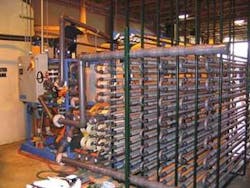Cost Effective Membrane System Meeting New EPA Regulations
As the U.S. Environmental Protection Agency has placed more stringent restrictions on industrial wastewater discharge, many manufacturers have chosen to outsource wastewater treatment to companies specializing in this complex, heavily regulated function.
Central Wastewater Treatment of Wisconsin (CWT) is one such wastewater remediation provider. Specializing in removing metal and oil from industrial wastewater and making the water clean enough to be released into a municipal sewage system, it serves over 35 customers statewide.
Rules = Opportunity
CWT was founded in 2003, when new EPA regulations were making it increasingly difficult for manufacturers to treat their own wastewater. The changes caused several local treatment facilities to go out of business, as these pre-existing conventional treatment facilities couldn’t afford to change their entire processes to meet stricter guidelines.
The 2003 guidelines primarily address classification and separation of wastewater streams for treatment. Previously, high concentrations of a contaminant in one type of wastewater could be mixed with other types of wastewater and diluted to an acceptable level. The new regulations disallow mixing wastewater streams of different types, thus forcing plants to treat these streams separately. This created a market opportunity that the facility, in West Allis, WI, near Milwaukee, filled.
The operation processes small batches of wastewater for different customers typically involved in metalworking - such as die casting and machining operations - producing difficult-to-treat wastewater high in metal and oil content. The facility meets all standards and regulations of the EPA, Wisconsin Department of Natural Resources and Milwaukee Metropolitan Sewerage District.
Beyond Membrane Filtration
In designing the new wastewater facility, CWT owner John Scherff sought a treatment system to reliably and cost-effectively purify the water, meet regulatory requirements and operate automatically with minimal manual intervention.
“I knew membrane filtration technology provides the best treatment method for my application because it offers a positive physical barrier that ensures solids and other contaminants are removed from the wastewater stream,” says Scherff. “The membranes give me and my customers confidence wastewater is properly and reliably treated according to all environmental regulations.”
This is important because any discharge limit violation results in the local sewage district levying fines and imposing a stringent testing regimen to make the plant prove the problem is corrected.
CWT’s closest competitor uses a conventional treatment process of adding chemical coagulants along with acids and bases to adjust pH and settle disposable solids. This process is labor intensive, consumes large quantities of chemicals and generates a great deal of sludge.
“Although my membrane system required a higher up-front capital investment, I’ll always have the overall cost advantage because of my lower chemical consumption, labor costs and sludge disposal costs,” said Scherff.
Less chemical handling also is safer for staff and reduces associated manufacture, transport and disposal costs for those chemicals (and sludge), which also benefits the environment.
Low-Fouling, Easy-to-Clean
CWT initially installed a tubular system with 1/2” nominal diameter membranes. Unfortunately, it experienced mixed results. Although the system produced clean discharge water, CWT faced problems with fouling and frequent and time-consuming cleanings - defeating the labor-saving benefits of membrane use.
Rather than buy a complete new system, CWT chose to retrofit its filtration system to incorporate the 1” tubular FEGTM Plus membranes from Koch Membrane Systems Inc. (KMS). This membrane design provides a wider flow channel and better resistance to fouling. “They’re able to handle the high solid content of our wastewater and variability between different wastewater streams,” said Scherff.
The polyvinylidene fluoride (PVDF) chemistry of this membrane provides temperature and chemical resistance, and the KMS “spongeball” cleaning method provides a mechanical cleaning technique that significantly cuts downtime and chemicals consumption.
Higher Productivity
“By switching to the KMS tubular membranes we’re spending much less time cleaning the membrane system, therefore dramatically increasing our productivity,” says Scherff. “We’re processing anywhere from 8,000-15,000 gpd, depending on wastewater composition. With the other membranes, we processed only about 5,000 gpd because fouling reduced membrane performance and we were cleaning 6-8 hours per day.”
The new membranes allow CWT to process wastewater 24 hours a day. The only downtime is during cleaning or an occasional Sunday when there’s no wastewater to process. The West Allis facility also decreased cleaning time of its small process tank to once every other day. Using these membranes, systems with larger tanks could decrease cleaning time even more.
“We spent thousands of dollars up front automating our process control systems to the point where it’s actually not necessary to have anyone here. Only a low-fouling membrane system can achieve this level of automation,” says Scherff.
Conclusion
The FEG membranes have been in use worldwide for over 30 years, removing solids, oily wastes and metals from wastewater streams in a variety of industries. With the assistance of KMS engineers, Scherff and his small staff of four quickly learned to predict how long it would take to treat each batch, despite wide variability in wastewater composition. This predictability allows CWT to optimize its entire treatment plant.
According to Scherff, “Our biggest accomplishment, which we’re most proud of, is we haven’t had a single violation of our discharge permit in the 17 months since the first day of operation. And that’s something our competitors cannot say.”
About the Author: Tim Jordan is Midwest regional sales manager for industrial water and wastewater for Koch Membrane Systems. Contact: 248-788-0502 or www.kochmembrane.com


